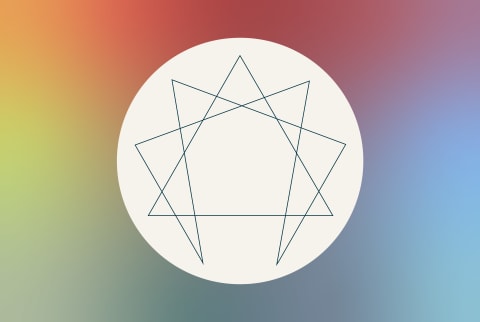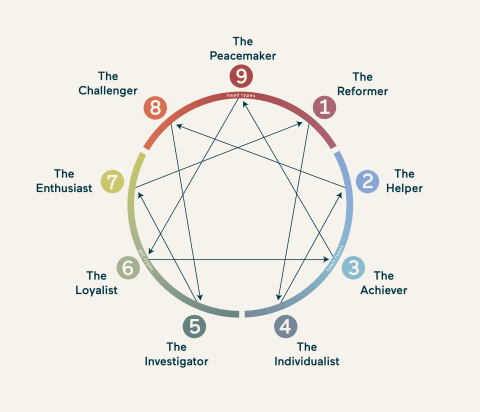
Image by Charlotte Benes / mbg Creative
February 1, 2023
You’ve probably heard of astrology, the Myers-Briggs Type Indicator, and maybe even Human Design—but what about the Enneagram of Personality?
According to this system of personality, each of us falls under one of nine types, with even more nuance depending on your “Enneagram wing.” Here’s what to know about the Enneagram and a breakdown of all the types, from experts.
Advertisement
This ad is displayed using third party content and we do not control its accessibility features.
What are the 9 Enneagram types?
The Enneagram is a personality typing system made up of nine personality types. According to Enneagram educator and relationship coach Julie Nguyen, the nine types are all defined by a core belief about the world, based on a person’s inherent essence and childhood experience.
“The core belief is likely subconscious and contracted in a limited ego state—meaning it’s comprised of your deepest motivations, fears, and the way that you interact in the world—which makes up how you perceive the world and the people around you,” Nguyen explains.

Image by Charlotte Benes / mbg Creative
Advertisement
This ad is displayed using third party content and we do not control its accessibility features.
Understanding your Enneagram type allows you to understand the world and why you behave the way you do, she adds. And as Enneagram educator and life coach Gina Gomez previously wrote for mindbodygreen, the Enneagram may be a personality test, but it offers much more than just that. “It’s a deep dive into our behavioral patterns. It allows us to see ourselves with compassion and the acceptance we’ve all been longing for,” she explains.
In terms of its history, Nguyen notes that the origins of the Enneagram are up for debate, “but what is agreed upon is that the Enneagram is made up of several different philosophy components derived from ancient Greek philosophy, Buddhism, Taoism, Islam, Christianity, and mystical Judaism.”
Enneagram type descriptions:
Type One: The Reformer
Type Ones, or the “Reformers,” are known for being logical and virtuous hard workers who often suppress their true desires. They have a deep need to be good, right, and even perfect, prioritizing morality and ethics. They can also be idealistic about the future and making the world a better place.
In terms of wings, a One with a Nine wing (1w9) will strive for perfection within themselves, while a One with a Two wing (1w2) will try to bring that perfection into society to be shared with others.
- Core fear: Being evil
- Core desire: To be a good person
- Core coping strategy: Reaction formation (aka feeling one way and doing the opposite)
- Enneagram One wings: 1w2 and 1w9
Advertisement
This ad is displayed using third party content and we do not control its accessibility features.
Type Two: The Helper
Enneagram type Twos, or the “Helpers,” are characterized by a need to be needed and serve others. They are friendly, loving, and eager to help other people but can often wind up ignoring their own needs in the process. Type Twos are typically likable, upbeat, and positive but may over-identify with how other people feel about them.
Further, the Two with a One wing (2w1) is more likely to help others on an individual basis, while a Two with a Three wing (2w3) will feel a stronger call to help larger groups.
- Core fear: Being unwanted or unneeded
- Core desire: To feel loved
- Core coping strategy: Repression (aka stifling one’s own feelings and needs)
- Enneagram Two wings: 2w1 and 2w3
Advertisement
This ad is displayed using third party content and we do not control its accessibility features.
Type Three: The Achiever
When it comes to Type Threes, also known as the “Achievers,” this Enneagram type is all about what they can do in the world to receive recognition. They want to be successful, but it has a great deal to do with their image and appearance. This type is goal-oriented, ambitious, and fast-paced, and known to overwork themselves for the approval of others.
In terms of a Three’s wings, a 3w2 (Three with a Two wing) will prioritize being the best in order to help other people, while a 3w4 (Three with a Four wing) will want to embody their individuality in the best way.
- Core fear: Being worthless
- Core desire: Being a person of value
- Core coping strategy: Identification (aka identifying with their successes to preserve their self-image)
- Enneagram Three wings: 3w2 and 3w4
Advertisement
This ad is displayed using third party content and we do not control its accessibility features.
Type Four: The Individualist
Type Fours, or the “Individualists,” according to the Enneagram system, are independent and free-spirited, but this also means they often feel misunderstood by everyone else. These people are the “seekers” of the bunch, unafraid to ask deep questions about their purpose, identity, and overall life. Imaginative, deep thinkers, and sometimes melancholic, this type is also known to isolate themselves.
In terms of wings, a Four with a Three wing (4w3) will be more inclined to share their individuality with others, while a Four with a Five wing (4w5) will be more reserved and express that individuality through creative pursuits.
- Core fear: Not being unique
- Core desire: Finding their true identity
- Core coping strategy: Introjection (aka internalizing/identifying with other people’s ideas)
- Enneagram Four wings: 4w3 and 4w5
Type Five: The Investigator
In the Enneagram, Type Fives, or the “Investigators,” are inquisitive, analytical, and pretty reclusive. They can be thought of as slightly removed from others, but it’s just because they value privacy and alone time. This type is genuinely excited to talk about things they know about, and they value self-reliance as well as logic.
The main difference between a 5w4 and a 5w6 (a Five’s possible wings) is the 5w4 is more concerned with fulfilling a purpose through their capabilities, while a 5w6 wants to use their capabilities to create a sense of safety and security.
- Core fear: Being incapable
- Core desire: Competency
- Core coping strategy: Isolation (aka retreating into one’s own mind)
- Enneagram Five wings: 5w4 and 5w6
Type Six: The Loyalist
Type Sixes, or the “Loyalists” of the Enneagram, prioritize feeling safe and secure in the world. They’re always looking out for how things could go wrong, so they get a reputation for being scaredy-cats. But in truth, they can actually be quite brave when it really counts, especially with regard to a cause they care about. They are loyal, albeit a bit anxiety-ridden.
When it comes to Six wings, a 6w5 (Six with a Five wing) tends to be much more introverted, while a 6w7 (Six with a Seven wing) want to make sure things are safe so they can enjoy themselves in the company of others.
- Core fear: Insecurity
- Core desire: Safety
- Core coping strategy: Projection (aka attributing your own undesired emotions or traits to someone else)
- Enneagram Six wings: 6w5 and 6w7
Type Seven: The Enthusiast
The Type Sevens of the Enneagram, or the “Enthusiasts,” are most concerned with avoiding pain—and boredom. As such, they like to keep busy, full of energy that makes them seek out fun and adventure. However, when they overbook themselves (which they’re known to do) they can easily become stressed and overwhelmed. They have strong potential to achieve but only when they can apply their talents with focus.
In terms of this type’s wings, a 7w6 (Seven with a Six wing) will want fun and adventure that feels safe, while a 7w8 (Seven with an Eight wing) will seek out opportunities to challenge themselves.
- Core fear: Pain and depravity
- Core desire: Contentment
- Core coping strategy: Rationalization (aka reframing undesired thoughts and emotions)
- Enneagram Seven wings: 7w6 and 7w8
Type Eight: The Challenger
Type Eights, or the “Challengers,” are fierce, assertive, and not afraid of confrontation. They’ll stop at virtually nothing in order to maintain a strong sense of control over their own lives—and sometimes others’. They do not like appearing weak or vulnerable, and they’re known to withdraw in an effort to protect themselves. That said, they do have a softer side when it comes to their loved ones.
The main difference between an 8w7 (Eight with a Seven wing) and an 8w9 (Eight with a Nine wing) is that the 8w7 uses their bold assertiveness to seek out good times to be had, while the 8w9 uses it to protect others.
- Core fear: Weakness
- Core desire: Self-protection
- Core coping strategy: Denial (aka not admitting the truth to oneself)
- Enneagram Eight wings: 8w7 and 8w9
Type Nine: The Peacemaker
Last but certainly not least, we have type Nines, or the “Peacemakers” of the Enneagram. This type is characterized by a keen ability to take in multiple perspectives, as well as meditate and literally make peace. That said, they can go so far as to abandon their own needs for the sake of others, even unconsciously. They’re inclined to go with the flow in order to keep the peace, even if that means doing things they don’t want to do.
The primary difference between a 9w8 (Nine with an Eight wing) and a 9w1 (Nine with a One wing) is that the 9w8 likes a challenge and isn’t afraid to assert themselves in an effort to achieve peace, while the 9w1 is more inclined to seek peace through perfectionism.
- Core fear: Loss and separation
- Core desire: Peace of mind
- Core coping strategy: Narcotization (aka numbing to avoid unwanted internal or external conflict)
- Enneagram Nine wings: 9w8 and 9w1
Enneagram type wings.
The Enneagram wings are the two numbers on either side of one type, and many people will display a unique combination of their dominant type with aspects of one of the wings more so than the other.
As Nguyen tells mindbodygreen, “If you identify as a Type One, your wings would be Nine or Two, so it’d be a 1w9 or 1w2, and this influences the way you view the world and extrovert your energy.” Sticking with that example, she adds that if you’re a Type One who leans toward your Nine wing, you’re likely to prioritize harmony, whereas if you lean toward the Two wing, you’re likely to channel your desire to improve the world on to other people.
Understanding your wings is important, Nguyen adds, because “it offers texture to numbers and presents further language for you to examine your behaviors have greater nuance, which gives you an opportunity for growth and multidimensional understanding.”
To find your wing, you would take an Enneagram assessment and look to see which wing on either side of your dominant type has the higher score. That number is your wing.
Here’s a full explainer on Enneagram wings for more information.
The three triads of Enneagram types.
According to Nguyen, the nine personality types are divided into three triads, or categories, which relate to our instincts. “Knowing your triad,” she says, “helps you understand your motivation, drive, style of social interaction, and how you may cope with stress.”
- Heart types: Types 2, 3, and 4, or the “heart types,” are the types that deal with their experience of shame—and how they deny, control, or express those feelings of worth and shame—from a feeling or heart-centered place.
- Head types: Also known as the thinking triad types, types 5, 6, and 7 are those who deal with the experience of fear through analysis, distraction, flight, or withdrawing themselves.
- Body or gut types: Types 8, 9, and 1 make up the gut types and are known to have strong gut feelings that deal with their expression, repression, denial, and anger.
FAQ
What are the 9 Enneagram personality types?
The nine Enneagram personality types are typically referred to by their actual number, though they also have nicknames as well: Type Ones (the Reformers), Type Twos (the Helpers), Type Threes (the Achievers), Type Fours (the Individualists), Type Fives (the Investigators), Type Sixes (the Loyalists), Type Sevens (the Enthusiasts), Type Eights (the Challengers), and Type Nines (the Peacemakers).
What is the most common Enneagram type?
According to Nguyen, there is some debate about which types are the most common versus the most rare, but types Seven and Nine are generally thought to be the most common.
Is there a rare Enneagram type?
Type Fours and Fives are thought to be the rarest Enneagram types, but again, Nguyen says this is anecdotal and up for debate.
The takeaway.
Personality assessments are a great way to introspect, get to know yourself better, and ideally, show you ways to become a more well-rounded person. And in the case of the Enneagram, this is one lesser-known personality test that can give you clues into your deepest fears, your purest motivations, and your greatest strengths.


